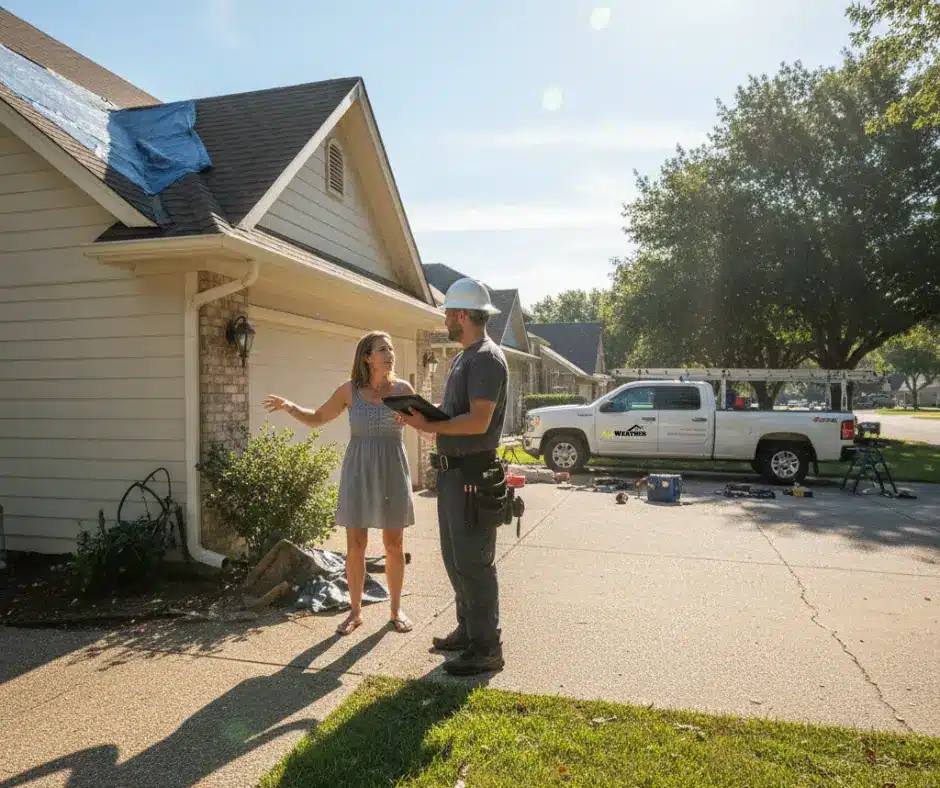Roof Financing FAQs: 11 Most Common Questions from Winnipeg Homeowners

Getting a new roof is expensive. It is one of the biggest home repairs you will ever face. The average homeowner in Winnipeg spends between $9,000 and $16,000 for a full roof replacement. Paying for it can feel overwhelming. You likely are searching for roof financing FAQs because of the many questions in your mind.
Do you need a loan? What about home equity? We know these questions are important. At All Weather Exteriors, we want to help you find the right solution for your budget. We have replaced more than 6000 roofs in the last 18 years. We have helped thousands of homeowners understand their financing options. In this guide, we answer 11 of the most common financing questions we get from homeowners just like you.
Key Takeaways:
- Compare local financing options, including low-interest home improvement loans, HELOCs, and deferred payment plans. Calculate the total cost, including interest, fees, and monthly payment.
- Prepare documents to speed approval, bring proof of income, ID, property tax bill, and a contractor estimate. Ask about credit score requirements and prequalification.
- Get all terms in writing, require a written warranty, proof of insurance, and a lien waiver on final payment. Confirm All Weather Exteriors obtains the required Winnipeg permits, and asks about provincial or city rebates.
Understanding Roof Financing
What is Roof Financing?
Roof financing covers any method you use to pay for a roof repair or replacement over time, rather than paying cash up front. Typical Winnipeg full roof replacements run between $7,000 and $20,000, depending on materials; you can shift that cost into monthly payments through loans, lines of credit, or contractor plans. Emergency repairs under $2,000 often use credit cards or short-term personal loans, while full replacements usually require larger, longer-term financing.
You should watch for high-interest sources, especially credit cards, which can push a $10,000 job into tens of thousands in interest over time. Insurance payouts can cover storm damage, but often leave you with a deductible. If you need funds before a claim settles, invoice financing or short-term contractor advances can fill the gap. Use the table below to compare common needs and what to expect.
| Asphalt shingle replacement | Typical cost $7,000–$12,000, 5–10 year financing is common |
| Metal roof replacement | Typical cost $12,000–$20,000, longer lifespan, longer-term loans are used |
| Emergency patch or leak | Typical cost $500–$2,000, paid with a card or short loan |
| Insurance-covered repairs | Deductible often $1,000–$2,500; claim timelines vary |
| Typical loan sizes | Common financing $5,000–$25,000, terms 1–25 years depending on product |
- Roof financing lets you spread large bills into manageable monthly payments
- Emergency repair options include short-term loans or credit
- An insurance claim can reduce your out-of-pocket costs, but it may delay work
- This contractor payment plan can offer promotional 0% periods for qualified applicants
Types of Roof Financing Options
You can choose between unsecured personal loans, secured options like a HELOC, revolving credit such as credit cards, or dealer and contractor financing programs. Typical unsecured loans run 1–7 year terms with rates roughly 5%–18% depending on credit; HELOCs use variable rates near prime, often lower than unsecured credit, and can stretch amortization to 15–25 years.
Contractor financing often advertises promotional 0% interest for 6–24 months or low fixed rates for longer terms; read the fine print for deferred interest clauses. High-cost credit cards carry rates around 19%–29%, which makes them a poor long-term choice for full replacements but acceptable for urgent small repairs.
| Personal loan | Fixed rate, 1–7 years, rates ~5%–18% |
| HELOC / Home equity | Variable rate, flexible repayment, lower rates if you have equity |
| Credit card | Immediate access, high interest ~19%–29%, short-term use only |
| Contractor financing | Promotional terms are possible, watch for deferred interest and fees |
| Insurance advance | Can cover catastrophe damage; you may need interim financing for the deductible |
If you face a $10,000 replacement and have meaningful equity, a HELOC at a variable rate of ~4%–6% can cost significantly less monthly than a 5-year personal loan at 7%–10%. If you lack equity and need fast repairs, a contractor plan or a short personal loan can get the job done quickly; compare the total cost, not just the monthly payment. Use your credit score, job stability, and timeline to rank options, and ask All Weather Exteriors for contractor plan terms you can verify in writing.
- Personal loan offers predictable payments and clear payoff dates
- HELOC gives lower rates if you accept variable interest
- Contractor financing can be fast and convenient, but check penalties
- The credit card option should be reserved for emergency repairs under a few thousand dollars
| Urgency | Short-term emergency use favors cards or short loans |
| Long-term cost | HELOC or secured loans usually have the lowest total interest |
| Credit score | Better scores unlock lower personal loan and contractor rates |
| Loan size | Small repairs fit cards; full replacements benefit from longer terms |
| Promotions | 0% offers save interest short-term, confirm deferred interest rules |

Common Questions about Roof Financing
How do I qualify for roof financing?
Lenders want to see steady income, a clean work history, and evidence that you own the property. Provide a recent contractor estimate, government ID, two most recent pay stubs, recent bank statements, and, if self-employed, the last two years of tax returns. Many lenders perform a soft credit pull for prequalification, then a hard pull once you apply.
Expect under 43% debt-to-income to sit well with mainstream lenders, though credit unions and specialty programs in Winnipeg may accept higher ratios. Home equity loans or HELOCs require usable equity, often at least 15–20% of home value. Unsecured personal loans and contractor financing tolerate lower equity but carry higher rates or shorter terms.
What credit score do I need for roof financing?
Canadian credit scores run roughly 300–900. Many lenders treat scores around 650 as the lower bound for standard unsecured offers. Scores of 720+ move you into prime pricing and broader options, including HELOCs and lower APR personal loans. Scores in the 600–649 band still qualify for some contractor plans and subprime lenders, but expect higher interest or larger down payments.
If your score sits under 600, you can still get financed, but typical routes include a co-signer, secured loan, or a contractor program that evaluates income over score. All Weather Exteriors can connect you with lenders that specialize in a range of credit profiles so you can compare offers without multiple hard inquiries.
Lowering credit utilization below 30% and fixing report errors delivers the fastest score gains before you apply. Soft prequalification checks let you assess rates without impact; by contrast, hard credit inquiries can shave a few points and show up for months, so group applications within a short window.
Costs and Payments
What are the typical costs associated with roof financing?
Typical roof replacement projects in Winnipeg run from about $6,000 to $12,000 for a standard asphalt shingle roof on a bungalow, while premium options like standing seam metal or cedar can push the price to $12,000 to $30,000 or more. You should budget additional line items: scaffolding and disposal ($400–$1,200), ice and water shield or underlayment upgrades ($300–$1,000), permit or inspection fees, and possible structural repairs ($500–$5,000) if sheathing or rafters need work.
Financing adds costs beyond the project price. Origination or admin fees often run from 0% to 5% of the loan, appraisal or inspection fees $200–$500, and late-payment fees typically 2%–5% of the missed payment. If you delay a roof replacement and water intrusion follows, cleanup and interior repairs can easily exceed the roof cost, so factor that risk into your financing decision.
How are roof financing payments structured?
Payments commonly come as fixed monthly installments, interest-free promotional periods, or variable-rate lines of credit. Terms range from short 6–24 month plans to long amortizations up to 15–20 years. You may see deferred-payment offers that push the first payment 30–90 days, or deferred-interest promotions that convert to full interest if the balance is not cleared by the promo end date; deferred-interest terms can be very costly if you miss the payoff window.
Typical rate and payment examples help you compare. Financing $12,000 at 6% over 20 years yields a monthly payment of about $86. The same $12,000 at 9% over 5 years costs roughly $249 per month. Many contractor plans accept little or no down payment, but those deals often carry higher rates or shorter promo periods, so check the total interest cost over the loan term.
Payment mechanics vary: most lenders take monthly pre-authorized debits, some allow biweekly schedules to lower interest, and secured options like HELOCs place a lien on your home while unsecured loans do not. Check for prepayment penalties, timelines for when payments start, and whether the lender reports to credit bureaus, because those details affect your cash flow and credit profile; ask All Weather Exteriors for the exact payment schedule and sample amortization before you sign.
Roof Financing FAQs: Choosing a Lender
Local lenders and contractor partners each bring different strengths. You can get lower rates from Winnipeg credit unions and major banks, quick approvals from contractor-arranged plans, or flexible terms from online lenders. All Weather Exteriors works with Financeit, a reliable financing company, and you can ask us how that lender handles warranty and job escrow.
Focus on the lender’s transparency and speed. Expect approvals in 24 to 72 hours for contractor financing, longer for secured home equity loans. Pick a lender that discloses fees up front, offers clear amortization schedules, and has a straightforward dispute process in Manitoba.
What should I look for in a roof financing lender?
Scan for a clear APR, itemized fees, and any prepayment penalty. Typical unsecured personal loan APRs can range from about 6% to 20% depending on credit; contractor promotions may offer 0% for 6 to 18 months. Ask whether the loan requires collateral, how fast funds are released, and whether the lender will coordinate payments directly to All Weather Exteriors.
Check customer reviews and local presence in Winnipeg. You want a lender that can explain the loan impact on your credit, provides written disclosures, and has experience with roofing projects that face seasonal timing pressures like spring ice dam repairs.
What to check in a lender?
| Item | Why it matters / Tip |
| APR | Shows annual cost, compare offers with the same term; lower APR cuts total interest. |
| Term length | Longer terms lower monthly payments but raise total interest paid. |
| Fees and origination | Upfront fees can offset low APR; ask for a full payoff quote. |
| Prepayment penalty | It can cost you hundreds if you pay off early; get it in writing. |
| Loan type | Unsecured vs secured: secured (home equity) often lowers the rate but increases the risk. |
| Approval and funding time | Fast funding matters for emergency repairs after storms or ice damming. |
| Contractor partnership | Preferred lender programs may simplify paperwork and payouts to All Weather Exteriors. |
| Customer service and dispute process | Local support and a clear complaint route in Manitoba give you leverage. |

How to compare financing offers?
Compare total cost, not just APR. Add interest plus all fees to get the full price over the loan term. For example, a $10,000 loan at 8% over 60 months yields about a $203 monthly payment, roughly $2,162 in interest, and a total payment of about $12,162. Use that baseline to judge other offers.
Watch for promotional traps like deferred interest, where a missed payment can make interest retroactive. Verify whether refunds or holdbacks are tied to job completion, and confirm whether the lender pays All Weather Exteriors directly or if you handle reimbursement.
Compare how each offer affects your monthly budget and emergency cushion. A low monthly payment over 10 years might cost thousands more in interest, and a secured option can put your home at risk if you default.
How to compare offers
| Criteria | What to do |
| APR vs total cost | Calculate total interest plus fees over the term; rank offers by total dollars paid. |
| Monthly payment | Match payment to your budget; test worst-case scenarios like job delays. |
| Prepayment and penalties | Avoid loans with heavy prepayment penalties if you plan to refinance or pay early. |
| Promotional terms | Get promo terms in writing, note the end date, and the consequences of missed payments. |
| Secured vs unsecured | Prefer unsecured for less risk to your home, accept secured only with clear benefit. |
| Funding speed | Pick faster funding for emergency repairs; slower funding may delay your project. |
| Warranty and payment flow | Confirm the lender will honor holdbacks tied to All Weather Exteriors’ warranty inspections. |
| Sample calculation | Run a 3 to 5-year example at each APR to compare monthly and total costs directly. |
Government Programs and Incentives
Are there any government programs for roof financing in Winnipeg?
You will not usually find roof-only financing from the City of Winnipeg, but several federal and provincial programs can reduce your net cost when you upgrade roofing as part of energy efficiency work. The federal Canada Greener Homes Grant historically offered homeowners up to $5,000 for eligible retrofit measures, including improved attic insulation and cool roofing products. Manitoba Hydro runs rebate and incentive programs that cover insulation and related envelope upgrades, which often pair with roof replacement projects.
Most programs require a pre-retrofit energy assessment, proof of work by a licensed contractor, and original receipts for your claim. False offers and door-to-door grant scams target homeowners. Verify eligibility only through official government or Manitoba Hydro channels, and never pay money to apply. All Weather Exteriors can coordinate assessments and provide the documentation you need to apply.
How can I take advantage of available incentives?
Start by checking federal and provincial program pages for current offerings and eligibility rules, then book an energy audit; audits in Winnipeg commonly run between $200 and $500. Secure any required pre-approval before you sign a contract, get at least two detailed quotes, and make sure your scope lists the exact products and measures the program covers, such as attic insulation R-values or ENERGY STAR roofing products.
Keep a tight paper trail. You will need the pre- and post-retrofit audit reports, contractor invoices showing labour and product line items, and proof of payment. Submit claims promptly, follow any inspection timelines, and ask All Weather Exteriors to complete post-work verification where allowed to speed reimbursement.
Practical sequence: arrange the energy assessment, confirm eligible measures, apply for pre-approval if required, book All Weather Exteriors for the work, retain original receipts, and complete the post-retrofit submission. Applying before you start work and using a contractor experienced with incentive programs will maximize your chances of receiving funds and reduce delays.

Common Pitfalls and Considerations
Avoid chasing the lowest bid. Bids that undercut the market by 20% to 30% often skip tear-off, use inferior underlayment, or hide permit and disposal fees. Winnipeg winter cycles and ice dam risk mean shortcuts on ventilation and ice-melt membranes cause failures within 3 to 7 years, not the 20 to 25 years you expect from good architectural shingles. Ask for an itemized scope, confirmed permit responsibility, and proof of WCB and liability coverage from the contractor.
Watch the financing fine print. Short promotional offers with deferred interest can jump to 20% or higher if you miss payments. Home equity lines usually carry variable rates; unsecured personal loans carry higher fixed rates. Match your financing term to the roof product lifespan and your resale timeline to avoid paying heavy interest on what becomes a short-term fix.
What mistakes should I avoid when financing my roof?
Signing without a fully itemized contract kills clarity. Demand line-by-line pricing for tear-off, disposal, underlayment, flashings, ice and water shield, vents, and labor. Get three written quotes and compare scope, not just totals. Verify the warranty: ask for both manufacturer and workmanship warranties in writing, and confirm who services warranty claims after installation.
Skipping contractor vetting and permits costs you more later. Check references from recent Winnipeg jobs, inspect photos of finished roofs, and confirm the crew’s liability and WCB insurance. Avoid buy-now-pay-later promos with hidden deferred-interest triggers. If you finance $10,000 at a high rate, you can pay thousands more in interest; choose terms that keep monthly payments manageable without doubling the total cost.
How can I ensure I’m making a sound investment?
Compare lifecycle costs, not just upfront price. Asphalt architectural shingles typically last 15 to 25 years in Manitoba conditions, while metal roofs can last 40 to 70 years. Factor in energy upgrades, ventilation, and ice-dam protection; adding a continuous eave-to-ridge ventilation and a peel-and-stick ice membrane in valleys can prevent premature failure and reduce attic heat loss. Ask All Weather Exteriors for past Winnipeg project reports and long-term performance notes.
Run financing scenarios against lifespan and resale plans. For a $10,000 roof, a 5-year loan at 6% yields about $193 monthly and $1,616 total interest. The same amount over 10 years at 7% drops monthly to about $116, but raises the total interest to about $3,932. That trade-off shows how shorter terms save interest, while longer terms protect cash flow; pick what matches your budget and the expected roof life.
From above, you now know the main roof financing options for Winnipeg roofs.
You must compare interest rates and total loan cost, not monthly payments alone. Get three written estimates, including All Weather Exteriors in your lineup. Check loan terms, prepayment penalties, and any fees. Ask about provincial rebates and energy incentives; factor permit and disposal costs into the total price.
Check your credit score, secure pre-approval, and set a clear budget. Prioritize materials rated for heavy snow and freeze-thaw cycles. Schedule work for spring or late summer to avoid freeze issues. Ask the contractor for a written warranty, proof of insurance, and a lien waiver upon final payment. Keep all receipts and warranties, and contact All Weather Exteriors for a free financing review and local guidance.

Leave a Reply
You must be logged in to post a comment.